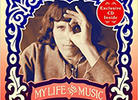
LET’S GO (SO WE CAN GET BACK)
AUTHOR: JEFF TWEEDY
PUBLISHER: DUTTON
Jeff Tweedy has been making music for a living for more than 30 years, going back to his first band Uncle Tupelo, which he formed with childhood pal Jay Farrar in 1987, and then, for the past 25 years, with Wilco. He’s Generation X’s version of Bob Dylan or Neil Young.
The two cover photos on his memoir, Let’s Go (So We Can Get Back), tell the story: a cherubic, pie-eyed youth on the front and a more wizened, bespectacled and bearded veteran on the back. Although he’s denied it, this memoir follows a similar path as Bruce Springsteen’s Born to Run book, which is ironic because Tweedy’s first stab at being an artist came from telling his grade-school classmates that a taped cassette of Born to Run was his own creation.
Like Springsteen, Tweedy Grew Up on Main Street, USA
In his case, Belleville, IL, a once-prosperous industrial hub a half-hour from St. Louis. Tweedy also had an overbearing, dismissive father who worked with his two way-older brothers on the railroad and a loving mother who encouraged his creative impulses and steered him away from the blue-collar world.

Tweedy discovered his love for music from reading about it, particularly Lester Bangs’ massively influential essay on The Clash for New Musical Express when he was merely 10 years old. He also honed his musical education from his brother Steve’s hip record collection “which ran the gamut from Harry Chapin to Kraftwerk to Frank Zappa to Ammon Duul,” and during his apprenticeship at the local indie retailer Record Works.
Tweedy’s Not Your Typical Rock Star Boasting of His Conquests
He married local promoter Sue Miller in 1995, and they have two sons, drummer Spencer (his cohort in the band Tweedy) and multi-instrumentalist Sammy.
After playing in an assortment of garage bands as a teen, Tweedy formed Uncle Tupelo with Farrar, which pretty much defined the emerging “No Depression” Americana movement at the time. After the band splintered in 1994, Tweedy formed Wilco with Tupelo bassist John Stirratt, new drummer Ken Coomer and ostensible co-leader Jay Bennett. After three albums on Warner/Reprise, the label decided to drop Wilco rather than release Yankee Foxtrot Hotel, which was deemed “not commercial” and rejected in 2001, forcing the band to distribute it digitally themselves.
Tweedy’s autobiography is predictably forthright and honest. For the most part, his life has been a series of fortunate events. And while Let’s Go, named after an expression of his father’s, is relatively free of tales of debauchery and drug-taking, one of its main narrative elements involve Tweedy’s former addiction to opioids, his experiences in rehab and his father’s own drinking problem.
Migraines and Depression Led Tweedy to Seek Pharmacological Help
His Vicodin use eventually led to a mental collapse and several rehab stays.
Prior to that, Tweedy smoked pot. He writes:
“No one in my family had driven their car off the road on weed, so I smoked weed until eventually my anxiety disorder began to make every bong hit result in an almost instantaneous heart-pounding panic attack. For a while, my drugs of choice were mundane and relatively benign—Diet Coke and cigarettes—which would have been a resounding victory for a guy with my DNA if I’d been able to freeze my drug use at that level of potency.”
The narrative takes us through different time periods—much like Bob Dylan’s Chronicles—but always returns to his bedrock beliefs and confessional nature. We learn that Tweedy writes lyrics by mumbling sounds until they form words and that he rarely listens to a song when he’s finished recording it.
Standing by his wife while she fought cancer, then living through the deaths of his parents, Tweedy seems to have learned a little bit about facing his fears. Like Springsteen, Tweedy’s journey involved coming to terms with where he came from while also breaking free from its grip. He, too, was born to run, landing in Chicago, less than 300 miles from where he grew up. Rock & roll saved his life, and now he’s trying to return the favor.
This review also appears in Freedom Leaf Issue 35.







